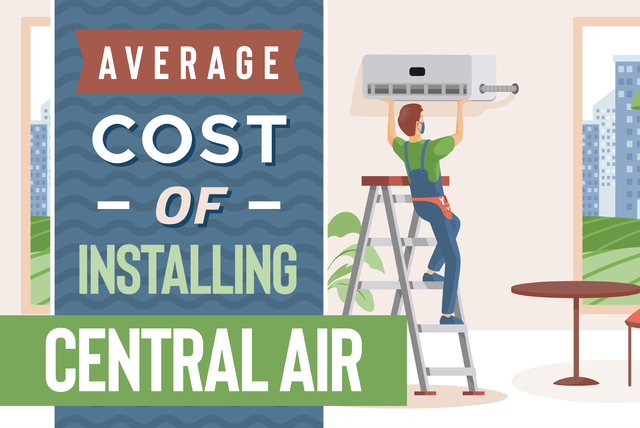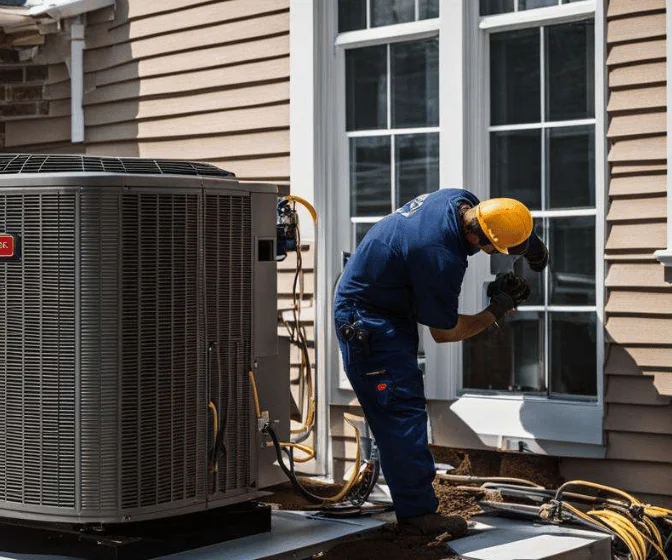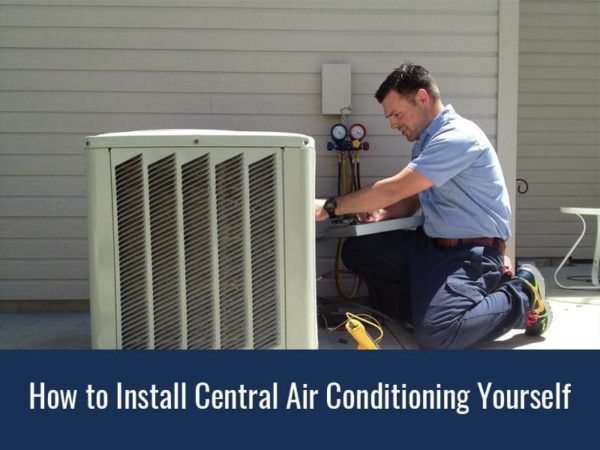What Does It Cost To Install Central Air

Frequently Asked Questions: Central Air Installation Costs
Installing central air conditioning is a significant investment in your home's comfort and value. Understanding the costs involved is crucial before you begin the process. This FAQ addresses common questions homeowners have about the price of central air installation.
Q1: What's the average cost to install central air conditioning?
The average cost to install central air conditioning typically ranges from $3,000 to $7,000. However, this is a broad estimate. The actual cost can vary considerably based on several factors, including:
- Size of your home: Larger homes require larger, more powerful units, increasing the cost.
- Type of system: Split systems, ductless mini-splits, and packaged units all have different price points.
- Existing ductwork: Homes with existing, usable ductwork will have lower installation costs than homes requiring new ductwork.
- Efficiency rating (SEER): Higher SEER ratings mean greater energy efficiency but also a higher initial cost.
- Brand and model: Certain brands and models are more expensive than others, even with similar features.
- Labor costs: Labor rates vary by region and contractor.
- Permits and inspections: Permits and inspections add to the overall cost.
For a more precise estimate, it's essential to get quotes from multiple qualified HVAC contractors in your area.
Q2: What factors influence the cost of central air installation the most?
Several key factors significantly impact the overall cost of installing central air. Here's a breakdown of the most influential:
- Ductwork: This is often the most significant cost driver. If your home doesn't have existing ductwork, installing it can add $1,500 to $4,000 or more to the project. The complexity of the ductwork design and installation also plays a role.
- System Size (BTU): The British Thermal Unit (BTU) rating of the air conditioner determines its cooling capacity. Larger homes require higher BTU ratings, leading to more expensive units. An undersized unit will struggle to cool your home effectively, while an oversized unit can lead to short cycling and higher energy bills. A professional load calculation is necessary to determine the correct BTU for your home.
- SEER Rating: The Seasonal Energy Efficiency Ratio (SEER) measures an air conditioner's energy efficiency. Higher SEER ratings mean lower energy bills over the lifespan of the unit, but they also come with a higher upfront cost. SEER ratings typically range from 13 to 25. While a higher SEER unit might cost more initially, the long-term energy savings can often offset the difference.
- Labor Costs: HVAC installation is a skilled trade, and labor costs can vary considerably depending on your location and the contractor's experience and reputation. It's always best to get multiple quotes and compare not just the price but also the contractor's qualifications, insurance, and warranty.
- Permits and Inspections: Most jurisdictions require permits for HVAC installations to ensure they meet building codes and safety standards. The cost of permits and inspections can range from $100 to $500, depending on your location. Failing to obtain the necessary permits can result in fines and delays.
Q3: How much does it cost to install ductwork for central air?
Installing new ductwork can significantly increase the overall cost of central air installation. The cost typically ranges from $1,500 to $4,000 or more, depending on the following factors:
- Size of the house: Larger homes require more ductwork, increasing the cost.
- Complexity of the design: Intricate designs with tight spaces or multiple levels will be more expensive to install.
- Materials used: Ductwork can be made from various materials, including sheet metal, fiberglass duct board, and flexible duct. Sheet metal is generally more expensive but more durable.
- Accessibility: Difficult-to-access areas, such as attics or crawl spaces, can increase labor costs.
If you already have existing ductwork, a contractor will inspect it to determine if it's in good condition and properly sized for the new air conditioning system. If the existing ductwork is inadequate, it may need to be repaired or replaced, adding to the overall cost.
Q4: What are the different types of central air systems, and how do their costs compare?
There are several types of central air conditioning systems, each with its own advantages and disadvantages in terms of cost and efficiency:
- Split Systems: Split systems are the most common type of central air conditioning. They consist of an outdoor unit (containing the compressor and condenser) and an indoor unit (containing the evaporator coil and blower). Split systems are generally the most cost-effective option for homes with existing ductwork. Installation costs typically range from $3,000 to $6,000.
- Packaged Units: Packaged units combine all the components (compressor, condenser, evaporator coil, and blower) into a single outdoor unit. They are typically used in homes without existing ductwork or where space is limited. Packaged units are generally more expensive than split systems, with installation costs ranging from $4,000 to $8,000.
- Ductless Mini-Split Systems: Ductless mini-split systems consist of an outdoor unit and one or more indoor units (air handlers) that are mounted on the wall. They don't require ductwork, making them a good option for homes without existing ductwork or for adding air conditioning to specific rooms. Ductless mini-splits are typically more expensive than split systems, with installation costs ranging from $3,000 to $8,000 per zone (indoor unit).
The best type of system for your home will depend on your individual needs and budget. Consult with an HVAC professional to determine the most appropriate option for your situation.
Q5: Are there any rebates or incentives available to help offset the cost of central air installation?
Yes, there are often rebates and incentives available from various sources to help offset the cost of installing energy-efficient central air conditioning systems. These can significantly reduce your upfront expenses.
- Federal Tax Credits: The federal government often offers tax credits for purchasing energy-efficient appliances, including air conditioners. Check the ENERGY STAR website for the latest information on available tax credits.
- State and Local Rebates: Many states and local municipalities offer rebates for installing energy-efficient HVAC systems. These rebates can vary widely depending on your location and the specific requirements of the program. Check with your state energy office or local utility company for available rebates in your area.
- Utility Company Rebates: Many utility companies offer rebates for installing energy-efficient appliances, including air conditioners. These rebates are often offered to encourage customers to reduce their energy consumption and lower their utility bills. Contact your local utility company to inquire about available rebates.
Be sure to research and take advantage of any available rebates or incentives to help reduce the overall cost of your central air installation.
Q6: How can I get the best price on central air installation?
Getting the best price on central air installation requires careful planning and research. Here are some tips to help you save money:
- Get Multiple Quotes: Obtain quotes from at least three different HVAC contractors. Compare the quotes carefully, paying attention to the details of what's included, such as the brand and model of the equipment, the warranty, and the installation costs. Don't just focus on the bottom line; consider the overall value.
- Consider Off-Season Installation: HVAC contractors are often less busy during the off-season (spring and fall), which means you may be able to negotiate a better price. They may also be more willing to offer discounts during slower periods.
- Ask About Discounts and Promotions: Don't be afraid to ask contractors about any discounts or promotions they may be offering. Some contractors offer discounts for seniors, veterans, or first-time customers.
- Choose the Right Size Unit: An oversized air conditioner will cycle on and off frequently, wasting energy and reducing its lifespan. An undersized unit will struggle to cool your home effectively. A professional load calculation will ensure you get the right size unit for your needs.
- Negotiate the Price: Once you have received multiple quotes, don't be afraid to negotiate the price with the contractors. Let them know you are getting other quotes and see if they are willing to lower their price.
- Consider a Less Expensive Brand or Model: While it's important to choose a quality air conditioner, you may be able to save money by opting for a less expensive brand or model with similar features and efficiency.
- Take Advantage of Rebates and Incentives: As mentioned earlier, take advantage of any available rebates or incentives to help reduce the overall cost of your installation.
By following these tips, you can increase your chances of getting the best possible price on your central air installation.
Q7: What are some hidden costs to watch out for during central air installation?
While initial quotes provide a good overview, certain hidden costs can unexpectedly increase the final price. Be proactive and inquire about these potential expenses beforehand.
- Electrical Upgrades: Older homes may require electrical panel upgrades to handle the increased power demand of a new central air system. This can add several hundred dollars to the project. Ask your contractor to assess your electrical system and include any necessary upgrades in the quote.
- Asbestos Abatement: If your home was built before the 1980s, there's a chance that asbestos-containing materials may be present in the ductwork or insulation. Asbestos abatement can be expensive and time-consuming. A qualified asbestos removal company should handle this.
- Permit Fees: As mentioned earlier, permit fees are required for most HVAC installations. Make sure the contractor includes these fees in the quote.
- Disposal Fees: Disposal fees may apply for removing the old air conditioning system and related materials.
- Unexpected Repairs: During the installation process, unforeseen issues may arise, such as damaged ductwork or wiring. Be prepared for the possibility of unexpected repairs, and discuss a contingency plan with your contractor.
- Home Modifications: Sometimes, minor modifications to your home may be necessary to accommodate the new air conditioning system, such as widening doorways or reinforcing floors. These modifications can add to the overall cost.
- Increased Energy Bills: While a new, energy-efficient air conditioner should lower your energy bills in the long run, your initial energy bills may be higher due to increased usage during the summer months. Factor this into your budget.
By being aware of these potential hidden costs and discussing them with your contractor upfront, you can avoid unpleasant surprises and ensure a smoother, more predictable installation process.






:max_bytes(150000):strip_icc()/CentralAC-51a9e6136f9c470e8390d9b4d9362a60.jpg)



